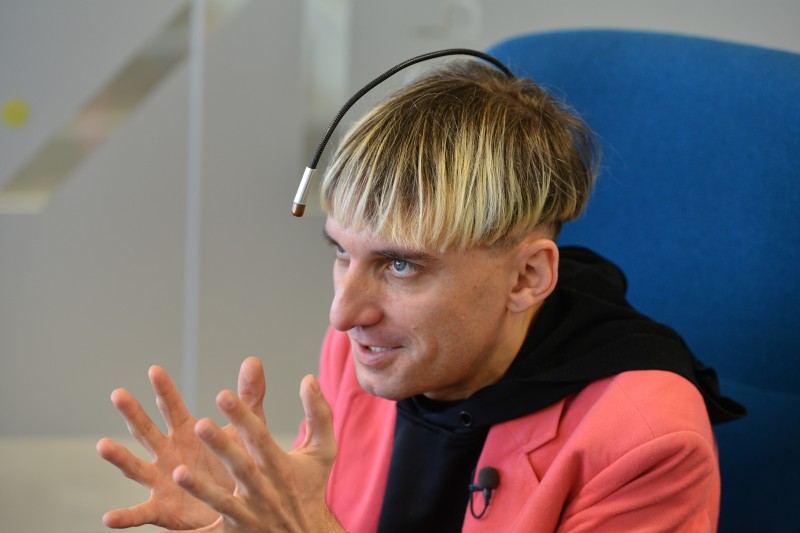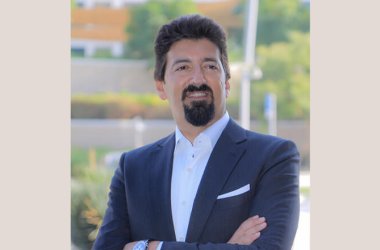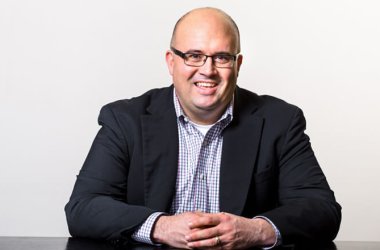
An inescapable irony shapes Neil Harbisson. Born colour-blind, his greyscale vision defined him in his formative years. Now, 15 years after receiving a foot-long antenna that protrudes from his grey matter, Harbisson is able to experience colour in a way that none of us can imagine.
The colours Harbisson now feels are anything but dull. The greyscale remains, but is now supported by a symphony of yellows and reds transmitted by his Internet-connected “organ”.
He is unequivocal in his belief that the world should embrace – and will be forced to adapt to – those who identify not only as owning technology, but consider it is as a part of themselves.
“My trans-species identity started long before becoming a cyborg,” he says. “The only species I connected with were those that saw in greyscale. Humans told me that I had a problem, or that I was disabled, but I didn’t agree. If you look at other species, it’s not a disability or a problem, but an advantage.”
Seeing in greyscale actually grants Harbisson certain superhuman capabilities. “It gives me night vision, I can see longer distances because colours don’t interfere, I can memorise shapes more easily, and detect camouflage more easily,” he says.
Determined not to be influenced by society’s norms, Harbisson set about collaborating with scientists and researchers in 2003 to find a new way that he could broaden his senses – even by the most unconventional means. “I wanted to find a new way of experiencing colour without changing my sight,” he says. “If you look at nature, insects have antennas that work 360 degrees, and aren’t limited to human vision.”
Harbisson’s antenna features Internet connectivity, which allows him to connect to – among anything else on the wide web – NASA’s international space station, which allows him to experience the colours of space. This, he says, is the most beautiful colour combination he has ever experienced. “Space is not black, it’s extremely colourful, but they are colours that we don’t see,” he says. “When I sense colours that are outside this planet, there are lots of ultraviolets that I don’t sense here.” Ultraviolet rays – which Harbisson says he has experienced in Dubai – have the ability to penetrate the skin, and can even kill. That doesn’t bother him, however. “Sensing it, while my body is here but my sense of colour is in outer space – I like it,” he says. “We’ll see the Internet as a sense more often, and it will allow us to explore space without physically being there.”
Since its installation, the general public’s fascination with Harbisson has understandably been incessant. While progress has been made in his mission to improve cyborg rights – his British passport photo now contains his antenna – which rules did not traditionally permit – there is still a long way to go to eradicate the stigma that surrounds his own personal identification.
The rise of wearable technology may have helped to change the attitudes of swathes of the public who would have initially been nonplussed, but, to the majority, he still remains a mystery. An outsider. “Some people think I’m wearing an antenna. I’m not wearing one, I have one,” he says.
Harbisson believes that changing the misconceptions around himself and other cyborgs are a question of looking beyond our own existence. “Humans inherently compare themselves with themselves,” he says. “If you break this bubble of human and start comparing yourself with other species, being blind, for example, is not a problem. There are many species that are completely blind and can live freely and independently. I like breaking this bubble, because we then no longer see disabilities as problems. I like seeing us as being aligned with other species.”
His antenna continues to illicit a broad range of emotions from strangers. “In society, if you stand out a bit, or aren’t trying to blend in, it usually creates a social reaction, generally a negative one. The antenna creates reactions like laughter, confusion or fear.”
As with so many of the world’s ills, the greatest challenge that Harbisson faces in his quest for acceptance is ignorance. However, the average person on the street cannot ignore the compelling arguments he offers for why incorporating technology into the human body is practical, selfless and sustainable. “The more we design ourselves, the less we’ll need to design the planet,” he says. “If we want to think about the future of earth, one way to be environmentally conscious is to change our own temperature. At night, we could use night vision instead of artificial light. We’ve cheated and changed the planet, so we should cheat with ourselves, and not with the planet. It’s affecting other species in a way that’s unfair. I think in the 2020’s we will see more people with new organs and senses, and society will get used to it. Hopefully they will see it is more ethical to do this.”
In the interim, the way that humans treat artificial intelligence systems is another area that fascinates and concerns Harbisson. He is encouraged by the world’s attitude to them, and believes that they, like cyborgs, will have to be given the respect they deserve. “I think AI will be classified and treated as a new species, and it is already happening,” he says. “With Sophia [the intelligent robot developed by Hanson Robotics] having a nationality and passport, that’s already giving AI specie status. I don’t think it’s a publicity stunt, and it’s a good way to make governments reflect about what is happening.”
Harbisson’s attitude towards AI is borne out of the idea that it will be an invaluable partner to mankind in coming centuries. “We will develop feelings towards AI, which will live longer than us,” he says. “In 300 years, AI’s like Sophia will have memories, and will be able to talk about history in a way that currently isn’t possible. We will value them because of their knowledge. It’s starting now and it’s good that we create situations where they are given nationalities.”
Back in the present, Harbisson views the Middle East’s leading city as one that will embrace the kind of change that he wants to see. “I feel that I am in the future when I am in Dubai,” he says. “There’s a lot of research and advancements, and I’m really pleased by the forward thinking on offer here.”
The UAE, meanwhile, renowned for its addiction to smartphones, could well be ripe for a wave of unprecedented change. The general public’s addiction to devices, Harbisson says, now renders us, on some level at least, at one with technology. “Most people are psychological cyborgs but don’t realise it,” he says. “Twenty years ago, people would have said ‘My phone is running out of battery,’ but now they just say ‘I’m running out of battery’, as if they were the smartphone. This first-person mention is already a sign of a psychological union, which is not far away from a biological one. People who are already psychologically united to technology won’t find it hard being biologically united to it.”
For now, Harbisson, the co-founder of The Cyborg Foundation, the international organisation that defends cyborg rights and supports people who want to become cyborgs, is committed to changing attitudes about his kind. “Society needs to understand that some people have senses and organs that are not traditionally human. Trans-species identity already exists, and needs to be recognised by society. If governments and bio-ethical committees accept these identities, they should also accept that we should be free to add senses and organs, and to decide what senses and organs we want to have as a species.”





